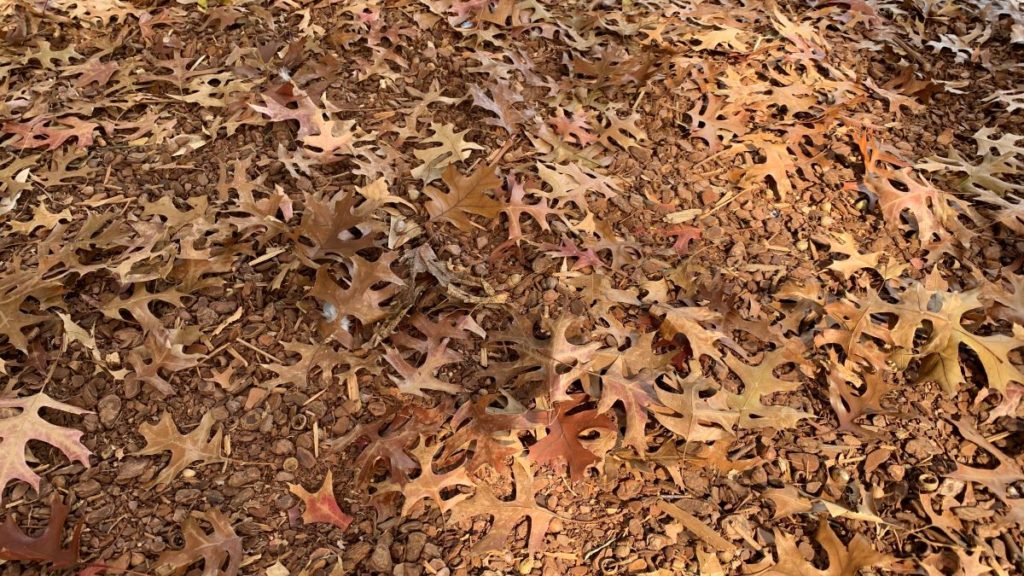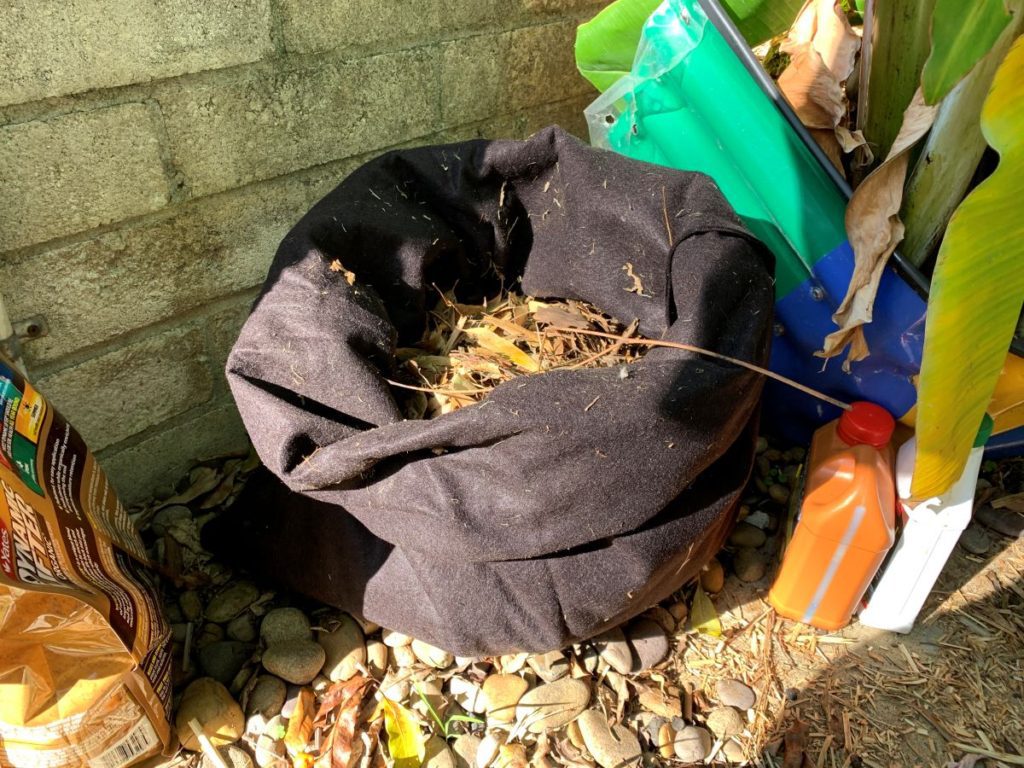Mulch leaves have fantastic benefits for your garden including organically controlling weeds, increasing soil microbe growth to break down and release nutrients for your plants. Mulched leaves will feed worms which will aerate your soil and digest the organic matter into humus improving soil structure. Mulched leaves are a free, easy, light-weight addition to your garden.
Benefits of leaf mulch for gardens
The top benefits of leaf mulch for gardens are they are free organic matter for improving your garden beds, they improve the water holding capacity of your soil, provide food for worms and bacteria which help to release nutrients to your plants.
Leaves will keep weeds out of your garden, saving you valuable time and will save on the amount of water you need to use as less will be lost out of your soil through evaporation.
How to make leaf mulch for your garden

Shred fall leaves and turn them into a rich leaf mulch for your garden. The two best ways to shred fall leaves are using your lawn mower or using a leaf blower. Here are the two best methods of making leaf mulch explained.
Lawn mower method
To turn dry fall leaves into leaf mulch lay them out first in a 1 inch layer across your lawn. Run over the leaves with your lawn mower 2-3 times which will shred them into small pieces, the size of pennies.
After the leaves have been shredded you can add the catcher to the back of your lawn mower to pick them up or rake them into a pile and move them to your garden with a wheelbarrow.

Leaf blower method
Use a leaf blower with the mulching attachment to easily shred and collect fall leaves. Many leaf blowers come with a shredding function, a larger nozzle and a collection bag. This is the simplest and easiest way to shred and collect leaves in one action.
After collecting the mulched fall leaves in your bag, you can simply empty them on top of your garden beds 2-3 inches thick.
How to add leaf mulch to your garden
Once you have shredded fall leaves into small pieces they can be added to your flower garden beds, under trees, around Mediterranean herbs or under fruit trees.
Use a mulch shovel if you have one or simply dump the whole wheelbarrow or bag full of leaves on your garden beds, avoiding any plants.
Use a rake to move the leaf mulch around your garden bed, around 2-3 inches thick. Leaf mulch can be added on top of old mulch on top of your garden, including bark mulch or straw.
All of these mulch types will break down together and the leaves will work their way into the
Water the leaf mulch after you have added it to your garden to hold it in place. If you are in a very windy area, a light layer of bark mulch will hold it in place.
Check out my previous article here on how to mulch windy spots.

When to add leaf mulch to the garden
The best time of year to add leaf mulch to the garden is early Fall. This will help to protect your garden soil over winter, reducing the impact of frosts and protecting the soil bacteria.
Depending on where you live, it can take until late fall before a large amount of leaves have reached the ground. This means that the best time to make leaf mulch is when you have a majority of your leaves on the ground and accessible.

Turn extra leaves into leaf compost
Leaves can also be mulched and bagged to turn it into compost. This is a great idea if you have too many leaves for your garden area.
To make leaf compost, collect the leaves and add them to a simple wire cage around 4x4x4 feet in size. Leaves will compact over the season and a large cage full of leaves will reduce in size to around 1/3. This can then be added to the top of garden beds as mulch in Spring.

Why you should mulch your leaves
Fall leaves from Oak trees, Jacaranda, Maple or deciduous fruit trees should be shredded before they are used as mulch. Large leaves can form a thick matting which can turn soil anaerobic and can form mold and turn soggy and even attract disease.
Fall leaves, will naturally form a blanket underneath the tree they fell from to smother out competing plants. For our home gardens, we want to make sure the soil can ‘breathe’ so shredding the leaves is essential.
How long it takes for mulched leaves to decompose
Garden beds
Mulched leaves that are laid in a thin layer, 2-3 inches across your garden beds will take around 3 months before they turn a dark color and break down. This is a fantastic feature of fall leaves as they will break down quickly when shredded to improve your soil.
Compost bins
A large amount of fall leaves, packed into a 4x4x4 feet square compost bin or cage will take around 6 months to completely break down to leaf mold. This leaf compost will be ready by the next Spring after allowing it to break down in a protected spot over 6 months.
For more on this process, check out my previous article, Mulching with Leaves: An Easy Guide.
Best leaves for mulch
The best leaves for making mulch come from deciduous trees which drop all of their leaves at once. While all trees will lose leaves over time, trees like Oak and Maple will drop a large amount within 2-3 weeks, making them easy to collect and mulch.
Here are the top leaves for mulch
| Tree Types | Benefits and notes |
| Oak | Large leaves which are easy to shred, they drop all of their leaves in a short period of time making it easier to collect. |
| Maple | Easy to shred leaves which break down quickly. |
| Jacaranda | Smaller leaves which fall down over a longer period compared to Oak. |
| Stone fruit | Less leaves but are smaller and can be left on the ground to break down where they fall. |
| Apple & Pear | Smaller leaves which are better shredded using a leaf blower with shredder attachment. |
| Grape Vines | Leaves dry quickly, raked up easily and great for compost. |
| Wisteria | Leaves fall down within a short period of time, easy to collect and can mix together with fallen flowers. |

Mulched leaves – FAQ
All leaves will make great compost however Eucalyptus leaves will take longer than most other types to break down. Shred them using a mower and mix together with lawn clippings and other fall leaves to help them to break down quicker.
Leaves can be left on top of flower beds over winter if they are in a thin layer. It is best to rake and shred them if you can. I often leave small amounts of fall leaves from overhanging trees to break down over winter and mix with my bark mulch.
Leaves from fall trees can be left on flower beds if they are not on top of the flower plants themselves and are in a thin layer where rain can get through to the soil. Large Oak leaves benefit from being collected and shredded and then placed back on top of your garden beds or composted.
Too many leaves can suffocate the soil and turn it anaerobic. This is where soil microbes break down the fall leaves without oxygen and can cause the mulch to smell. Thick mulch layers on garden beds can attract mold so only leave them on if they are thin and allow rain to get through to the soil.
Leaf mulch can be used on your garden beds, lawn, vegetable patch or flower garden once it has been shredded. Layer the leaf mulch 2-3 inches thick and water it in to hold it in place. It can also be mixed with other mulch types such as straw or bark chips to break down and improve the soil structure.
Are mulched leaves good for the garden? | Summary
Mulched leaves are great for the garden added as a top dressing underneath trees and on garden beds or broken down and turned into compost. Save time by mulching leaves on top of your lawn and letting them break down to improve the soil.
For more on mulching leaves for grass check out my previous article here.
Happy Mulching.
I am an accredited practicing dietitian, experienced gardener and a dedicated cook. I love writing and sharing my experience so you can learn from my successes and mistakes.

Comments are closed.